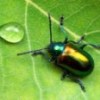What was that dazzling sequence of nucleotide bases? Here's a more holistic view:

The gene was ribonucleotide reductase, which is essential for DNA synthesis. If you followed the BLAST results back through to the paper where this sequence was published, you'll see that the researchers were interested in this gene because some of their mosquito cell lines were showing resistance to a chemical, hydroxyurea, that is used to synchronize cell cultures. This gene was linked to the resistance, and sequencing it allowed them to see that copy number, rather than nucleotide sequence, differed between resistant and non-resistant cells.
No one picked the research question, but JasonC is awarded 5 points for getting the organism first, and 1 point each is awarded to commentators Gunnar, Keith Bayless, and Kelvin for contributing additional relevant information.

Since we've arrived at the end of April, it's also time to announce the month's cumulative points winner: JasonC, with 15 points.
If you could email me at your earliest convenience, Jason, we'll get you fixed up with your loot.

Congrats, JasonC!